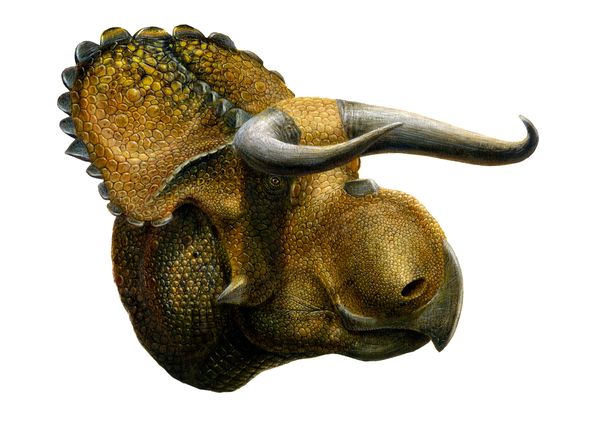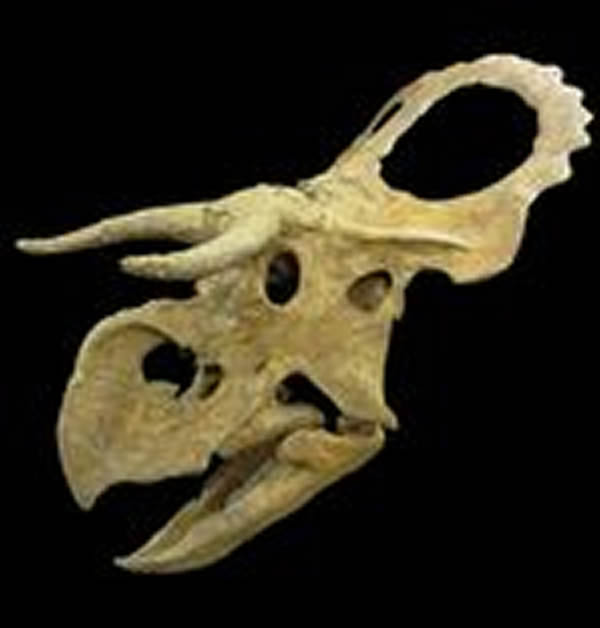New Big-Nosed Horned Dinosaur Found in Utah
An illustration shows how Nasutoceratops titusi may have looked.
Nasutoceratops' skull, reconstructed. Photograph courtesy Rob Gaston
Paleontologists have discovered a new dinosaur, a Triceratops relative with a supersize schnoz that once roamed present-day Utah.
Nasutoceratops titusi belonged to a group of horned dinosaurs called ceratopsids, large four-legged herbivores that thrived during the Cretaceous period, according to a study released Tuesday.
Most ceratopsids were Triceratops-style, with huge heads bearing a small horn over the nose, a horn over each eye, and a ornate frill—a bony protrusion that fanned out over the base of the neck.
But the newfound dinosaur looked quite different, with a small horn over its oversize nose; extremely long, curved horns over its eyes; and a simple frill without hooks and spikes.
The first part of the name Nasutoceratops titusi translates to "big nose horned face" in Latin.
Study co-author Scott Sampson, a paleontologist at the Denver Museum of Nature and Science, suspects Nasutoceratops were slow-moving, wandering in big herds for protection.
The males likely used their "headgear" to compete for mates, locking those curved horns in battles for dominance, said Sampson, whose study was published July 17 in the journal Proceedings of the Royal Society B.
The horns may have also served as visual signals to other males, essentially sending the message "don't mess with me because I'm bigger than you," Sampson said.
Paleontologist Matt Lamanna, of the Carnegie Museum of Natural History in Pittsburgh, said that the horns may have also helped the herbivores defend themselves.
"When you're carrying big spears on your head, if something's trying to eat you, you might use them," said Lamanna, who was not involved in the new study.
A Paleontologist's Dream
Nasutoceratops lived on Laramidia, an isolated landmass that formed when a shallow sea flooded central North America during the Cretaceous, about 75 million years ago.
The vegetarian dinosaur munched on plants in a swampy, Louisiana-like bayou alongside lots of other dinosaurs not far from the coast. Sampson, a National Geographic grantee, called it "gorgeous beachfront property, like wall-to-wall Jamaica."
"Just put up a few electric fences to keep out Tyrannosaurus and you'd be all set," he quipped.
Today, said Sampson, the vast expanse of untouched badlands is a a "paleontologist's dream."
Within the continental United States, he said, "it's the last great relatively unexplored dinosaur boneyard."
The second part of the name Nasutoceratops titusi honors Alan Titus, a paleontologist at the Grand Staircase-Escalante National Monument in southern Utah, which encompasses the area where the fossils were found.
Dinosaur Diversity
Nasutoceratops' wildly different appearance from other ceratopsids may testify to to the existence two distinct communities of distantly related Cretaceous dinosaurs on Laramidia.
"If you were to take a time machine back to western North America 75 million years ago and walk north from what is now southern Utah to Alberta, Canada, you'd encounter at least two distinct sets of dinosaurs along the way," noted Lamanna, saying such regional differences also applied to other groups of dinosaurs.
"But until recently, evidence for this type of latitudinal zonation in dinosaurs had been very limited," making Nasutoceratops "an important discovery," he said.
Added study co-author Sampson: "This find raises some great questions and mysteries. We're just beginning to understand the world of dinosaurs."
Christine Dell'Amore
National Geographic News
Published July 16, 2013













